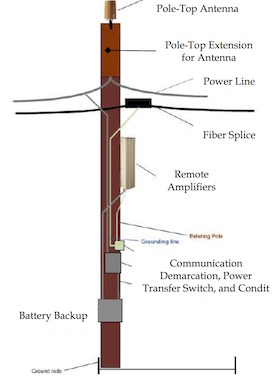
Lower obstacles for higher poles.
Mobile broadband carriers – i.e. licensed cellular telephone companies – now have the same access to utility poles in California as wireline telephone and cable companies. That’s the result of a unanimous California Public Utilities Commission decision that modified the rules for attaching wireless broadband equipment, including ancillary gear such as power cabinets and back up batteries, to poles…
With one exception, the amended ROW Rules provide CMRS carriers with the same access to utility infrastructure as CLECs and CATV corporations. The one exception pertains to pole-attachment fees. Currently, the ROW Rules allow public utilities to charge each CLEC and CATV pole installation an annual attachment fee equal to 7.4% of a utility’s cost-of-ownership for the host pole. The 7.4% fee is based on the assumption that a CLEC or CATV pole installation occupies one vertical foot of pole space.
It’s not completely open season on utility poles, though. Mobile carriers still have to at least ask for local permit approvals in order to install wireless equipment in the public right of way. However, cities and counties in California are working under much tighter shot clock requirements – either approve or deny a permit within a certain amount of time, or it’s automatically granted – and any denials or conditions can, in effect, be appealed to the CPUC.
There’s also a process for getting permission from a pole owner, which doesn’t always run smoothly or to a schedule. However one frequent objection – that a pole can’t physically handle any more weight – isn’t as big a problem for mobile carriers as for wireline companies. Mobile companies only need a few, scattered poles, not miles and miles of them, so one pole will often do as well as another, and in any event the cost of replacing a single pole is relatively inexpensive compare to the alternative of building a new tower.
